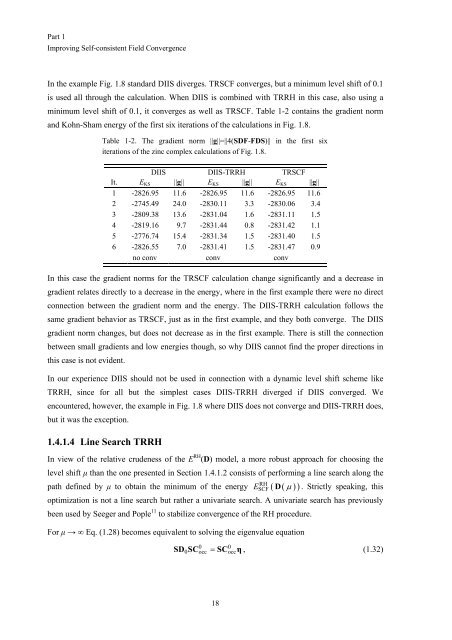Get my PhD Thesis
Get my PhD Thesis
Get my PhD Thesis
Create successful ePaper yourself
Turn your PDF publications into a flip-book with our unique Google optimized e-Paper software.
Part 1<br />
Improving Self-consistent Field Convergence<br />
In the example Fig. 1.8 standard DIIS diverges. TRSCF converges, but a minimum level shift of 0.1<br />
is used all through the calculation. When DIIS is combined with TRRH in this case, also using a<br />
minimum level shift of 0.1, it converges as well as TRSCF. Table 1-2 contains the gradient norm<br />
and Kohn-Sham energy of the first six iterations of the calculations in Fig. 1.8.<br />
Table 1-2. The gradient norm ||g||=||4(SDF-FDS)|| in the first six<br />
iterations of the zinc complex calculations of Fig. 1.8.<br />
DIIS DIIS-TRRH TRSCF<br />
It. E KS ||g|| E KS ||g|| E KS ||g||<br />
1 -2826.95 11.6 -2826.95 11.6 -2826.95 11.6<br />
2 -2745.49 24.0 -2830.11 3.3 -2830.06 3.4<br />
3 -2809.38 13.6 -2831.04 1.6 -2831.11 1.5<br />
4 -2819.16 9.7 -2831.44 0.8 -2831.42 1.1<br />
5 -2776.74 15.4 -2831.34 1.5 -2831.40 1.5<br />
6 -2826.55 7.0 -2831.41 1.5 -2831.47 0.9<br />
no conv conv conv<br />
In this case the gradient norms for the TRSCF calculation change significantly and a decrease in<br />
gradient relates directly to a decrease in the energy, where in the first example there were no direct<br />
connection between the gradient norm and the energy. The DIIS-TRRH calculation follows the<br />
same gradient behavior as TRSCF, just as in the first example, and they both converge. The DIIS<br />
gradient norm changes, but does not decrease as in the first example. There is still the connection<br />
between small gradients and low energies though, so why DIIS cannot find the proper directions in<br />
this case is not evident.<br />
In our experience DIIS should not be used in connection with a dynamic level shift scheme like<br />
TRRH, since for all but the simplest cases DIIS-TRRH diverged if DIIS converged. We<br />
encountered, however, the example in Fig. 1.8 where DIIS does not converge and DIIS-TRRH does,<br />
but it was the exception.<br />
1.4.1.4 Line Search TRRH<br />
In view of the relative crudeness of the E RH (D) model, a more robust approach for choosing the<br />
level shift µ than the one presented in Section 1.4.1.2 consists of performing a line search along the<br />
RH<br />
path defined by µ to obtain the minimum of the energy E SCF ( D ( µ )). Strictly speaking, this<br />
optimization is not a line search but rather a univariate search. A univariate search has previously<br />
been used by Seeger and Pople 11 to stabilize convergence of the RH procedure.<br />
For µ → ∞ Eq. (1.28) becomes equivalent to solving the eigenvalue equation<br />
0 0<br />
0 occ = occ<br />
SD SC SC η , (1.32)<br />
18

















